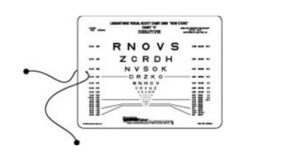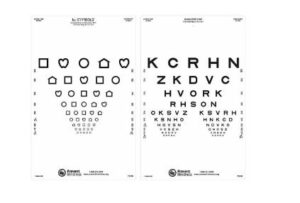Adult Vision Health: Ages 18-59
66% of Wisconsin adults aged 40 and older have some type of visual impairment, causing disruptions and complications in daily activities and quality of life.
Healthy vision is essential for success in school, the workforce, and in life, yet the negative impact of undetected and untreated vision problems is often overlooked. 44% of older adults don’t think they have to seek regular vision care because they don’t have any current vision concerns or issues.
What is an Adult Vision Screening?
An Adult Vision Screening checks asymptomatic people for vision concerns and refers those who are at risk for an eye disease or vision concern on to further vision care.
What Do We Detect When Vision Screening Adults?
An Adult Vision Screening determines an adult’s risk for possible vision concerns based off previous and current vision health history and family history of vision problems. The Adult Vision Screening also checks adults’ visual acuity, testing their near and distance acuity (how clearly they see both far and up-close).
What are the Approved Approaches to Complete an Adult Vision Screening?
An Adult Vision Screening consists of the following four sections:
1. Registration Form/Risk Assessment: At the start of the vision screening, clients are asked to fill out a registration form with their basic information including name, contact information, and demographics. The rest of the form contains a vision risk assessment. The vision risk assessment asks 10 questions that will help determine whether the adult is at risk for age-related eye disease. Topics that the questions ask about include history of pre-existing conditions, eye injuries, risk factors, and date of last eye exam.
2. Near Acuity Screening: The Sloan Letter Near Acuity Chart is the approved method of vision screening near acuity in adults. This chart tests an adult’s vision acuity, or how sharp their vision is, at a standardized distance. Each eye is occluded individually, and the adult is measured at a 14-inch testing distance.

3. Distance Acuity Screening: The Sloan Wall Chart is the approved method of vision screening distance acuity in adults. Each eye is occluded individually, and the adult is measured at a 10-foot testing distance. One side of the Sloan Wall Chart shows letters and the other side shows shapes; both are approved for vision screening.

4. Exit Interview: The Certified Vision Screener will explain the results of the risk assessment and the visual acuity tests with the client to make sure they understand their results and recommendations for next steps. The certified vision screener will determine if a referral to an eye care professional is appropriate, provide recommendations for scheduling an eye exam, and emphasize the importance of regular, dilated eye exams.
These methods have been approved by Prevent Blindness’s scientific advisory committee. More information can be found here.
Common Vision Conditions
A refractive error is a defect in the optics of the eye that results in lack of precise focus of the light rays on the retina causing a blurred image.
Definition: or Farsightedness, is a type of refractive error. Hyperopia is a vision condition in which near objects appear blurry but objects in the distance remain clear.
Hyperopia treatment: Glasses and contact lenses are most commonly used to treat hyperopia in adults.
Definition: or Nearsightedness, is a type of refractive error. Myopia occurs when distant objects are blurred, while objects up close are seen with more clarity.
Myopia treatment: The rate of myopia is increasing rapidly. By 2050, it is predicted that half of the world population will have myopia. This is due to overexposure and use of screens/digital devices and lack of time spent outdoors. Glasses and contact lenses are most commonly used to treat myopia in adults.
Definition: Astigmatism occurs due to an irregular curvature of the cornea preventing light rays from focusing on a single point on the retina. Most corneas have some degree of astigmatism. However, as the curvature of the cornea becomes more uneven, image distortion increases. Astigmatism is often inherited.
Astigmatism treatment: Adults will often need glasses and contact lenses to help correct their astigmatism.
Definition: Presbyopia is caused by the changes in the eyes that occur naturally due to aging. With age, the lens inside of the eye becomes less flexible. This causes light rays that travel through the lens to land directly on the retina. This results in difficulty seeing objects up close. Presbyopia usually becomes noticeable in the early to mid-40s.
Presbyopia treatment: Glasses and contact lenses can be used to treat presbyopia in adults.
Adult Vision Resources
Additional Resources:
Vision Care Voucher Program Information
Contact Us:
For additional questions please email [email protected].
